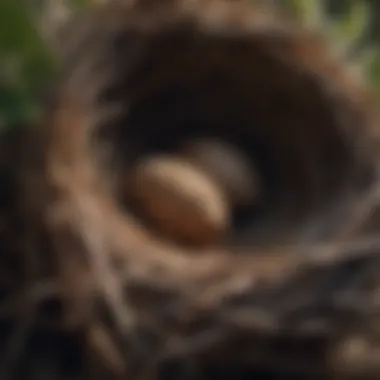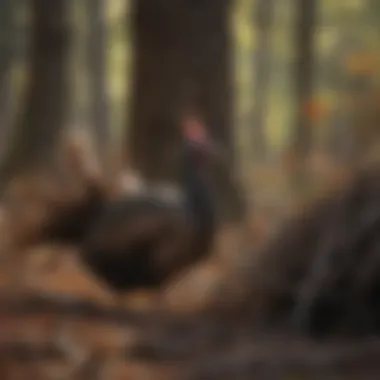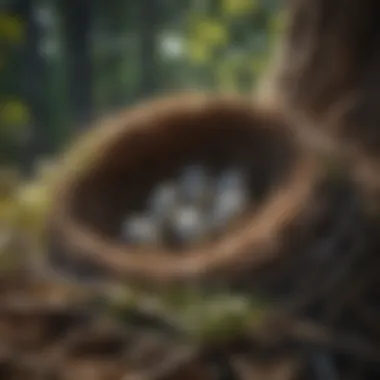Understanding Turkey Nests: Structure and Characteristics


Intro
Turkey nests are fascinating structures that showcase both the ingenuity and adaptability of these birds. Understanding the construction and characteristics of these nests gives insight into the behaviors of wild turkeys during their critical nesting periods. The design of a turkey nest is not arbitrary; it reflects a blend of environmental factors and instinctual behaviors. Observing this aspect of wildlife can enlighten pet enthusiasts and animal lovers alike, fostering a deeper appreciation for the natural world around us.
Nest Structure
Wild turkey nests display a unique assembly, primarily crafted from a mixture of grasses, leaves, and feathers. These components serve various purposes, from insulation to camouflage. The nest is typically a shallow depression, which helps in keeping the eggs secure and minimizing exposure to potential predators.
- Location: Turkey nests are usually located on the ground in areas that afford cover, such as thickets or underbrush.
- Egg Laying: Female turkeys, called hens, lay an average of 10-15 eggs per clutch. This strategic number balances the need for sufficient offspring while managing resource availability.
Behavioral Characteristics
The behavior exhibited by wild turkeys during nesting reflects a complex blend of instinct and interaction with their environment. Hens show particular behavior patterns during this critical time.
Nesting Rituals
Prior to laying eggs, turkeys perform a series of rituals. These can include:
- Site Selection: The hen carefully chooses a location that provides adequate shelter from the elements and predators.
- Nest Preparation: This involves arranging nesting materials for comfort and protection.
Brooding Behavior
Once the eggs are laid, the task of incubation begins. Hens generally incubate their eggs for approximately 28 days. During this time, they will leave the nest only for necessary feeding, drinking, or maintenance activities.
Local Variations
There is variation in nesting habits across different regions. In some areas, turkeys may adapt their nesting to fit local conditions like climate and habitat availability. Noting these regional differences can provide a more nuanced understanding of turkey nesting behavior in general.
Understanding the nesting habits of wild turkeys can contribute to broader discussions about wildlife conservation and habitat protection.
Ending
The exploration of turkey nests—through structure and behavior—offers a captivating glimpse into the natural instincts of these birds. As wildlife enthusiasts, recognizing the intricacies of nesting not only enriches our understanding but also enhances our appreciation for these remarkable creatures in their habitats.
Intro to Turkey Nesting
Nesting is crucial for the survival of many species, and wild turkeys are no exception. Understanding this aspect of their behavior sheds light not just on their life cycle, but also on the environmental factors that influence it. Turkey nesting practices are fascinating, revealing how these birds adapt their nesting strategies in response to their surroundings. This section aims to explore the essential elements of turkey nesting, providing insights that can benefit wildlife enthusiasts and pet owners alike.
Understanding Wild Turkeys
Wild turkeys, native to North America, are a remarkable species. They exhibit complex behaviors, including social interactions and adaptive strategies for survival. Adult male turkeys, known as toms, can weigh between 11 to 24 pounds, while females, called hens, are usually smaller. Turkeys possess keen eyesight, enabling them to spot potential dangers, which greatly influences their nesting choices and locations. This bird primarily feeds on seeds, nuts, and insects, further integrating its habitat into its nesting behavior. Understanding wild turkeys is essential for appreciating their nesting habits.
The life cycle of a wild turkey includes several phases, with nesting being critical for continuation of the species. Understanding their breeding cycle and habitat preferences leads to noticeable patterns in their nesting. A keen observer can learn much by watching these beautiful birds.
Purpose of Nesting


Nesting serves multiple important functions for wild turkeys. The primary purpose is reproduction and ensuring the survival of the young. The nest acts as a secure environment to protect eggs from predators and environmental threats. Hens typically lay between 10 to 15 eggs, which they incubate for around 28 days.
Additionally, nesting allows the female turkey to establish a territory. By selecting specific locations for nesting, hens can avoid competition and enhance the safety of their offspring. This aspect of nesting shows their intelligent behavior, as they evaluate factors such as cover from predators and proximity to food sources.
Several elements factor into the purpose of nesting:
- Protection: Keeping eggs safe from predators.
- Reproductive Success: Increasing the chance of hatchlings' survival.
- Territoriality: Establishing space for themselves and their young.
Ultimately, the nest is integral to the life cycle of turkeys, directly impacting future generations.
Physical Characteristics of Turkey Nests
Understanding the physical characteristics of turkey nests is essential for anyone interested in the life of wild turkeys. These characteristics offer insights into how turkeys adapt to their environment, ensuring both survival and successful reproduction. Studying these nests reveals not just the biology of these birds but also their behavioral patterns and interactions with the ecosystem.
Size and Structure
The size of turkey nests varies, typically ranging from 12 to 24 inches in diameter. This variability is influenced by factors such as the age of the female and the availability of nesting materials. Generally, older hens tend to construct larger nests. The structure of a turkey nest is relatively simple but functional.
A typical nest is a shallow bowl, often situated on the ground. This positioning allows the hen to camouflage effectively, an important aspect for protecting the nest from predators. The depth of the nest usually reaches about 4 to 6 inches, providing just enough space for the eggs while still maintaining concealment. This deliberate choice of size underscores the significance of both safety and comfort during the incubation phase.
Additionally, the strategic placement of the nest emphasizes the turkey’s instinctive behaviors. Nests are often located in areas with dense foliage or tall grasses. Such locations provide cover from potential threats while also offering a warmer microclimate for the developing eggs.
Materials Used in Nest Construction
When it comes to materials, wild turkeys exhibit a remarkable ability to utilize what is available in their surroundings. Common components used in building nests include grasses, leaves, and small twigs. These elements serve as both bedding and insulation.
The selection of materials is influenced by the local environment. In wooded areas, for example, hens may incorporate more leaves and feathers, utilizing natural resources to enhance the nest's warmth. Conversely, in open areas, the nests might contain more grasses, which provide a softer, more supportive base.
Turkeys also engage in a behavior known as
Behavioral Aspects of Nesting in Turkeys
Understanding the behavioral aspects of nesting in turkeys is essential for comprehending how these birds interact with their environment and ensure the survival of their offspring. This section explores various behaviors exhibited by wild turkeys during three critical phases: pre-nesting, nesting rituals, and brooding and incubation. Each phase reveals unique insights regarding their adaptation strategies and social behaviors, which have significant implications for wildlife enthusiasts and those interested in turkey conservation.
Pre-Nesting Behavior
Before a turkey lays its eggs, various behaviors set the stage for nesting. Female turkeys, commonly referred to as hens, engage in specific actions to prepare for the nesting season. These behaviours include:
- Site Selection: Hens often scout potential nesting locations well in advance of egg-laying. They prefer areas that provide adequate cover and proximity to food sources. The right site helps protect the eggs from predators.
- Drumming Call: During the pre-nesting phase, hens may be less vocal but still communicate through subtle calls. This behavior is crucial for establishing territory and attracting mates.
- Social Interactions: Some studies indicate that hens may gather in groups before nesting, engaging in social interactions. This behavior possibly helps them gain experience in selecting nesting sites and avoiding predators.
With such pre-nesting behaviors, turkeys enhance their chances of success by thoroughly preparing for the reproductive cycle.
Nesting Rituals
Nesting rituals play a vital role in a hen’s reproductive success. These actions not only signify the commencement of the nesting process but also reinforce the bond between the hen and potential mates. Key rituals include:
- Courtship Display: Male turkeys, known as toms, undergo elaborate courtship displays to attract hens. These displays involve puffing up feathers, strutting, and creating a series of low-frequency calls. Successful courtship is crucial for a hen to choose a mate.
- Nest Building: Once a female has chosen her mate, she constructs a nest. The process involves scratching the ground and arranging materials like leaves, grass, and feathers to create a safe environment for her eggs.
- Laying Eggs: Turkeys typically lay one egg per day, often creating a clutch of around 10 to 14 eggs. The laying period is critical as the hen should remain undisturbed during this phase.


These rituals are not just instinctive behaviors; they represent the culmination of social dynamics and environmental interactions that ensure the continuation of the species.
Brooding and Incubation
Once the eggs are laid, the hen enters a critical phase of brooding and incubation. This period is vital for the development of the embryos, and the behaviors exhibited by the hen during this time are noteworthy. Main aspects include:
- Incubation Period: A turkey's incubation lasts about 28 days. During this time, the hen remains on the nest most of the day, occasionally leaving for short periods to feed.
- Temperature Regulation: The hen instinctively maintains the eggs at a stable temperature by adjusting her position on the nest. This behaviour is crucial for egg viability and hatching success.
- Protective Actions: Hens display strong protective instincts during incubation. They may use body shielding techniques to cover the eggs and use alarm calls to warn off potential threats.
These behaviors not only ensure that the eggs remain viable but also demonstrate the hen's commitment to nurturing her future offspring. The outcome of these strategies often determines the survival rate of the chicks once they hatch.
“Behavioral aspects of turkey nesting reflect an intricate relationship between the birds and their environment, shaping their reproductive success.”
In summary, the behavioral aspects of nesting in turkeys provide valuable insights into their adaptation strategies. Understanding these phases is essential for wildlife enthusiasts and anyone interested in the complexities of avian life. By observing these behaviors, one can gain a deeper appreciation of the challenges turkeys face in their natural habitats.
Variation in Turkey Nesting Across Regions
Understanding how turkey nesting varies across regions is essential for conservation efforts and for those simply interested in wildlife behavior. The differences in nest structures and locations can provide insights into the adaptation of wild turkeys to their environments. By examining regional variations, we can appreciate the complex relationship between turkeys and their habitats, which affects their nesting success and overall survival.
Geographical Differences in Nest Features
The geographical variations in nesting features reflect the diverse habitats that wild turkeys occupy. In some areas, nests may be built in dense cover, like shrubs and tall grass, while in other regions, they might be found in open fields or woodlands. This distinction not only affects the physical attributes of the nests but also their success in terms of protecting eggs and chicks from predators.
For example, turkeys residing in the Eastern regions of the United States often build their nests on the ground in wooded areas, using leaves, pine needles, and grass. On the other hand, birds in the more arid regions, such as parts of the West, might utilize sand or other materials more prevalent in their environment.
- Eastern Nesting: Dense foliage for cover
- Western Nesting: Utilize available materials of local climate
It is known that certain adaptations take place according to the availability of resources, which includes both nesting materials and cover for protection. These adaptations highlight an impressive evolutionary trait of wild turkeys: their ability to thrive in various environments by modifying their nesting habits.
Environmental Factors Influencing Nesting
Several environmental factors significantly affect turkey nesting behaviors. These factors can alter not only where turkeys choose to nest but also how successful their nesting attempts will be.
- Climate: Changes in temperature and weather patterns can impact the availability of food sources and nesting materials.
- Predation: Areas with higher predator density may see turkeys nesting in more concealed locations to enhance safety.
- Land Use Changes: Urbanization and agriculture can reduce habitat availability, influencing where turkeys might establish their nests.
- Vegetation Growth: The type and density of vegetation can determine nesting site suitability and availability.
Understanding these factors is crucial for wildlife preservation efforts. By recognizing how turkeys respond to their environment, we can support conservation strategies that help sustain turkey populations.
In summary, grasping the regional variations in turkey nesting and the environmental influences on these behaviors can foster a greater understanding of wildlife interactions. It informs conservation efforts and enhances awareness for those interested in observing wild turkeys in their natural habitats.
Challenges Faced by Wild Turkeys During Nesting
Nesting is a critical stage in the life cycle of wild turkeys. However, various challenges can hinder their success during this period. Understanding these challenges provides insight into the complexities of their reproductive behavior and the factors influencing turkey populations. Addressing these concerns is crucial to wildlife conservation efforts.
Predation Risks
Wild turkeys face severe threats from predators during nesting. The location of their nests, often on the ground, makes them susceptible to various carnivorous species. Common predators include raccoons, foxes, and birds of prey. The risk of predation can significantly impact the survival rates of turkey eggs and young poults.
Key Factors in Predation


- Nest Location: Turkeys prefer secluded spots, but nests in open areas are more vulnerable.
- Timing: Nests laid early in the season may be more at risk as predator populations rise with the warming weather.
- Behavioral Adaptations: Turkeys exhibit certain behaviors, such as flattening their bodies, to avoid detection. Despite these efforts, they remain at high risk.
Successful nesting ultimately depends on the ability of wild turkeys to evade these predation risks, which not only affect individual success but also have broader implications for population numbers.
Human Encroachment
Human activities significantly influence nesting success. Urbanization and habitat destruction lead to reduced nesting sites, forcing turkeys into less suitable areas. Human encroachment on natural habitats can also increase stress levels in wild turkeys, affecting their nesting choices.
Impact of Human Activities
- Habitat Loss: Deforestation and agricultural expansion result in fewer safe nesting areas.
- Recreational Activities: Increased human presence in forests can disturb nesting turkeys, causing them to abandon nests.
- Pollution: Contaminated environments may also pose health risks to turkeys, which can affect their reproductive abilities.
Closure: The Importance of Turkey Nesting
Nesting is a critical behavior in the life cycle of wild turkeys. Understanding its importance offers insights into the species' ecology, their role in the ecosystem, and necessary conservation efforts. This article illustrates specific elements that contribute to the overall relevance of nesting.
Contributions to Ecosystems
The nesting behavior of turkeys plays a significant role in their environment. By selecting certain sites for their nests, wild turkeys influence plant growth. Their nesting sites can become crucial habitats for various forms of wildlife. Abandoned nests eventually decay, enriching the soil and promoting vegetation that can support other species. This interaction underlines that nesting is not merely a reproductive behavior; it directly contributes to local biodiversity and ecosystem health.
Wild turkeys also help in seed dispersal. As they forage for food near nesting sites, they inadvertently spread seeds that aid in forest regeneration. Their presence fosters a balance in ecosystems where both they and other animal species thrive.
Implications for Wildlife Conservation
The nesting of wild turkeys demands attention in wildlife conservation efforts. As human activities continue to encroach on natural habitats, understanding nesting patterns becomes crucial. Protecting nesting areas can help sustain turkey populations while maintaining ecosystem stability. Conservation initiatives aimed at safeguarding nesting sites directly correlate to the success of turkey reproduction and population recovery efforts in various regions.
Additionally, recognizing the threats wild turkeys face during nesting, such as predation and habitat loss, informs conservation strategies. By fostering a supportive environment, wildlife organizations can effectively promote healthy turkey populations. This awareness fosters a deeper appreciation for the intricate dynamics of wildlife and their habitats, encouraging collaboration between conservationists and the public to preserve these key species.
In summary, the importance of turkey nesting extends beyond individual birds. It influences entire ecosystems and should be a priority in conservation discussions.
Further Reading and Resources
Exploring the world of turkey nests can be both fascinating and enlightening. To gain a better understanding of turkey behavior and nesting habits, one should consider diving into further resources. These materials not only provide richer insights but also contribute to a broader knowledge base about wildlife interactions and conservation efforts. Engaging with additional literature helps deepen one's appreciation for the complexity of turkey nests and their ecological significance.
Books on Turkey Behavior
Various books focus on the nuanced behaviors of turkeys, providing readers with a comprehensive understanding of their life cycle. Some notable titles include:
- The Wild Turkey: Biology and Management by William M. Healy: A thorough guide detailing the anatomy and behaviors of wild turkeys, their habitats, and the threats they face.
- Wild Turkeys: A Natural History by Thomas M. McGowan: This book explores the natural history of wild turkeys, their behavior, and nesting patterns, making it a valuable resource for both enthusiasts and professionals.
- Turkey Trouble by Wendi Silvano: While this book is more light-hearted, it provides insight into turkey behavior through whimsical storytelling, making it accessible for younger readers and families.
These resources offer detailed observations about turkey life, which can augment what has been discussed in this article. It also allows readers to analyze behaviors in various contexts, which can enhance their understanding of the species.
Research Articles on Nesting Patterns
For those seeking academic insight, research articles on turkey nesting patterns offer valuable data and detailed observations. Such articles typically include:
- Studies on Nesting Success in Eastern Wild Turkey: An article detailing the factors affecting the success of nests in Eastern regions of the United States.
- Impact of Habitat on Turkey Nesting: This research provides information on how various habitats affect nesting success and behavior, highlighting the importance of environmental factors.
- Behavioral Adaptations of Wild Turkey: An analysis of how wild turkeys adapt their nesting behaviors based on environmental pressures and predation risks.
These articles contribute significantly to the understanding of turkey nesting by providing empirical data and analysis. By combining findings from these studies with practical knowledge and observations, readers can gain a multifaceted perspective on turkey nesting.
Engaging with literature and academic research helps shape informed conservation strategies and improves the understanding of wildlife phenomena.
The exploration of further resources empowers readers to not just see turkeys as creatures in the wild, but to understand their roles in ecosystems, their struggles, and especially their nesting behaviors.







